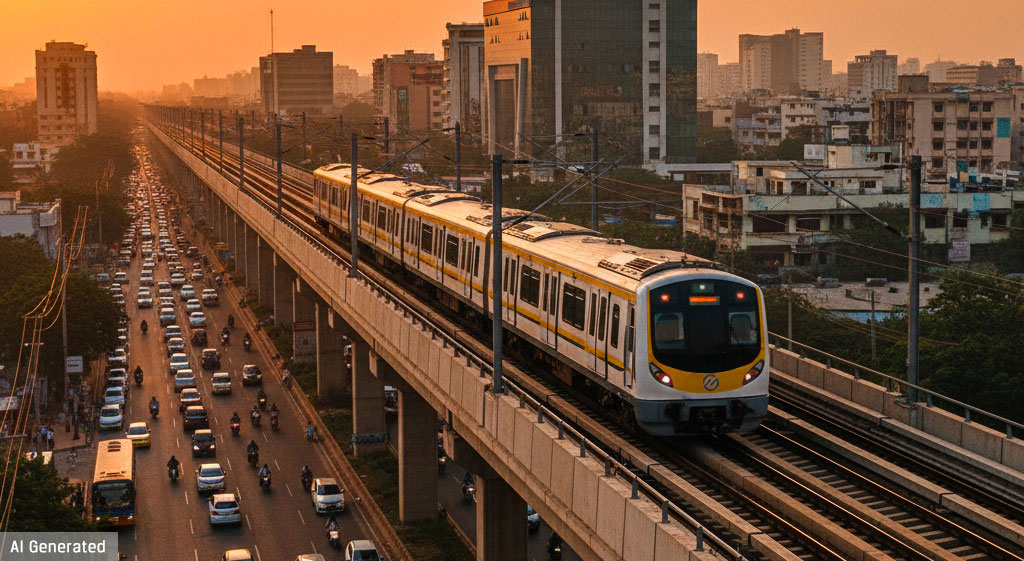
Bengaluru is a city defined by its dynamism. As a global hub for technology and innovation, it’s an embodiment of remarkable growth and boundless potential. With this energetic expansion comes a unique opportunity: to build an urban landscape that can sustain its own momentum. Keeping Bengaluru on the move, ensuring its talent can connect, collaborate, and create, is a shared challenge that inspires forward-thinking solutions. The Namma Metro is a powerful answer to this call; a modern lifeline designed not just to navigate the city, but to fuel its future.
The journey to create this transformative network is a story of shared vision and collective effort. It’s about understanding a city’s needs and working together to build a solution that touches millions of lives.
Every day, the Bengaluru Metro transforms millions of individual journeys into a seamless city-wide network that fuels Bengaluru's growth. This is more than a transportation system; it's the city's circulatory system, connecting the critical nodes of a thriving metropolis. We see its impact in the way it links the vital economic corridors of Electronic City and Whitefield, enabling the city’s brightest minds to collaborate and innovate with greater efficiency. This connectivity empowers the tech professional, boosting productivity and strengthening the backbone of India’s Silicon Valley.
Simultaneously, it provides students from areas like RV Road with reliable access to premier educational institutions, nurturing the future talent pool that will continue to drive our nation forward. It allows families to connect with the city's rich social and commercial fabric, from the green expanses of Cubbon Park to the bustling markets of Chickpet, fostering community and driving the local economy. Each journey represents a shared success, demonstrating how visionary metro infrastructure can unlock a city's true potential.
When the Bangalore Metro Rail Corporation Ltd. (BMRCL) began laying the groundwork for the incredible vision of the Bengaluru Metro, we saw an opportunity to contribute our expertise via our steel and cement projects and be a partner in building this legacy for the people of Bengaluru. For a project of this monumental scale and social importance, ensuring the absolute safety, durability, and resilience of the structure was a collective responsibility.
The elevated corridors of Bengaluru Metro, that soar over the city and the stations that welcome millions, required a foundation of immense strength. Our contribution came in the form of a steel project with JSW Neosteel TMT rebars. These high-strength steel bars, developed by JSW Steel through advanced technology, provide the crucial tensile strength within the cement pillars of the Yellow Line and the Pink Line of Bengaluru Metro for generations to come.
The material provided by JSW Group meets the highest standards of structural integrity and seismic resistance for Bengaluru Metro. We were able to uphold the most important promise of this project: the safety and security of every single commuter.
A modern city's metro infrastructure should not only be strong but also responsible. The ambition for the Namma Metro was to build in a way that contributes positively to Bengaluru’s environment. This aligns with JSW's belief that progress and sustainability must go hand in hand. We found a shared purpose in this goal through the use of JSW Cement's Ground Granulated Blast Furnace Slag (GGBS).
GGBS is a green cementitious material that offers enhanced durability and a significantly lower carbon footprint compared to traditional cement. By incorporating it into the concrete mix for the Metro’s foundations, tunnels, and stations, we were able to contribute to a more sustainable construction process. This choice reflects a shared commitment to building responsibly, ensuring that as we build a better-connected Bengaluru for today, we are also preserving its environment for tomorrow.
Namma Metro is a powerful symbol of what India can achieve. It is a project built in India, for India, and largely by India. This spirit of self-reliance and national capability is at the core of the 'Make in India' vision, a vision JSW Group is deeply committed to. Our involvement in the Bengaluru Metro is a source of immense pride, as it represents our role in a larger story of nation-building.
The 23830 metric tonnes of JSW Steel and 16962 metric tonnes of JSW Cement that now form the backbone of Bengaluru Metro’s Yellow line were manufactured domestically. More of JSW Steel and JSW Cement is on it's way to the construction sites of Bengaluru Metro’s Pink line. This reflects our investment in the nation's industrial capacity.
By contributing to critical urban metro infrastructure, we are not just supplying materials; we are participating in a collaborative effort to build the modern, world-class cities our country deserves. It is a partnership where our industrial strengths are used to serve a public purpose, creating a virtuous cycle of growth and development that benefits everyone.
Namma Metro is not the end of the story, but a new beginning for Bengaluru. With each new line and every journey taken, the city becomes more connected, more efficient, and more vibrant. As Bengaluru continues to innovate and grow, the need for robust, sustainable, and intelligent infrastructure will only increase.
We see ample scope for continued partnership and innovation in meeting the mobility needs of India's future cities. Our journey with the Namma Metro has been a privilege, an opportunity to learn, contribute, and grow alongside a city we admire. At the JSW Group, we remain optimistic about the future and committed to our role as a partner in progress, ready to help build the foundations for wherever Bengaluru’s ambitious journey takes it next.
As a foundational partner in modernising India's urban transit, JSW Group has supplied high-strength steel and sustainable cement to build the metro rail lifelines in major cities, such as Delhi Metro, Mumbai Monorail and Underground Metro, Bengaluru Metro, and Chennai Metro, to name a few. Our materials form the structural backbone of these critical infrastructure projects, powering the nation's progress and connecting millions of people every day.